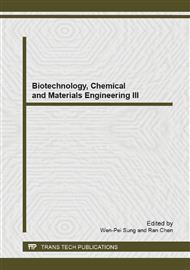[1]
Emma Stanton and Claire Lemer. Hope of Migraine Sufferers, Int J Health Care Qual Assur, Volume 24, Issue 2. (2011).
Google Scholar
[2]
Natoli JL, Manack A, Dean B, et al. Global Prevalence of Chronic Migraine: A Systematic Review. Cephalalgia, 30(5): 599-609. (2010).
DOI: 10.1111/j.1468-2982.2009.01941.x
Google Scholar
[3]
Lyngherg AC, Jensen R, Rasmussen BK, et al. Incidence of Primary Headache: A Danish Epidemiologic Follow-up Study. Am J Epidemiol, 161(11): 1066. (2005).
DOI: 10.1093/aje/kwi139
Google Scholar
[4]
Paul R. Hanlon and David M. Barnes. Phytochemical Composition and Biological Activity of 8 Varieties of Radish (Raphanus sativus L. ). Sprouts and Mature Taproots. J Food Sci, 76(1): C185. (2011).
DOI: 10.1111/j.1750-3841.2010.01972.x
Google Scholar
[5]
Satoru Tamura, Kouji Tsuji, Piao Yongzhen, et al. Six New Acylated Anthocyanins from Red Radish (Raphanus sativus). Chem. Pharm. Bull, 58(9): 1259. (2010).
DOI: 10.1248/cpb.58.1259
Google Scholar
[6]
Yoshiaki T, Yoshihito K, Tadashi F, et al. Antioxidant Constituents of radish Sprout (Kaiware-daikon), Raphanus sativus L. J. Agric. Food Chem, 51( 27): 8061. (2003).
DOI: 10.1021/jf0346206
Google Scholar
[7]
Hirotaka K, Yoshiyuki M, Masnobu O, et al. Chemistry and Antioxidative Activity of Hot Water Extract of Japanese radish (Daikon). BioFactors, 21(2): 211. (2004).
DOI: 10.1002/biof.552210142
Google Scholar
[8]
Phil-Dong Moon and Hyung-Min Kim. Anti-inflammatory Effect of Phenethyl Isothiocyanate, an Active Ingredient of Raphanus sativus L. Food Chemistry, 131(4): 1332. (2012).
DOI: 10.1016/j.foodchem.2011.09.127
Google Scholar
[9]
M.G. Buzzi1, C. Tassorelli. Experimental Models of Migraine. Handbook of Clinical Neurology (Chapter 8), Volume 97, Pages 109–123. (2010).
Google Scholar
[10]
S Akerman, PR Holland and J Hoffmann. Pearls and Pitfalls in Experimental in Vivo Models of Migraine: Dural Trigeminovascular Nociception. Cephalalgia, 33(8): 577-592. (2013).
DOI: 10.1177/0333102412472071
Google Scholar
[11]
Amol Bhandare, Neeraj Vyawahare, Ajay Kshirsagar, et al. In vivo and in Vitro Screening of Antimigraine Drug: Studies in Animal Model of Migraine. Int J of Pharma Res Dev, 2(9): 11-21. (2010).
Google Scholar


